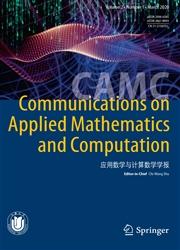Meta-Auto-Decoder: a Meta-Learning-Based Reduced Order Model for Solving Parametric Partial Differential Equations
IF 1.4
4区 数学
Q2 MATHEMATICS, APPLIED
Communications on Applied Mathematics and Computation
Pub Date : 2023-08-14
DOI:10.1007/s42967-023-00293-7
引用次数: 0
Abstract
Many important problems in science and engineering require solving the so-called parametric partial differential equations (PDEs), i.e., PDEs with different physical parameters, boundary conditions, shapes of computational domains, etc. Typical reduced order modeling techniques accelerate the solution of the parametric PDEs by projecting them onto a linear trial manifold constructed in the offline stage. These methods often need a predefined mesh as well as a series of precomputed solution snapshots, and may struggle to balance between the efficiency and accuracy due to the limitation of the linear ansatz. Utilizing the nonlinear representation of neural networks (NNs), we propose the Meta-Auto-Decoder (MAD) to construct a nonlinear trial manifold, whose best possible performance is measured theoretically by the decoder width. Based on the meta-learning concept, the trial manifold can be learned in a mesh-free and unsupervised way during the pre-training stage. Fast adaptation to new (possibly heterogeneous) PDE parameters is enabled by searching on this trial manifold, and optionally fine-tuning the trial manifold at the same time. Extensive numerical experiments show that the MAD method exhibits a faster convergence speed without losing the accuracy than other deep learning-based methods.元自动解码器:一种求解参数偏微分方程的元学习降阶模型
科学和工程中的许多重要问题都需要求解所谓的参数偏微分方程,即具有不同物理参数、边界条件、计算域形状等的偏微分方程。典型的降阶建模技术通过将参数偏微分方程投影到离线阶段构造的线性试验流形上,从而加速了参数偏微分方程的求解。这些方法通常需要一个预定义的网格以及一系列预先计算的解决方案快照,并且由于线性分析的限制,可能难以在效率和准确性之间取得平衡。利用神经网络(NNs)的非线性表示,我们提出了元自解码器(MAD)来构造非线性试验流形,其最佳性能在理论上由解码器宽度来衡量。基于元学习的概念,可以在预训练阶段以无网格和无监督的方式学习试验流形。通过搜索这个试验流形,可以快速适应新的(可能是异构的)PDE参数,同时还可以对试验流形进行微调。大量的数值实验表明,与其他基于深度学习的方法相比,MAD方法具有更快的收敛速度和精度。
本文章由计算机程序翻译,如有差异,请以英文原文为准。
求助全文
约1分钟内获得全文
求助全文
来源期刊

Communications on Applied Mathematics and Computation
MATHEMATICS, APPLIED-
CiteScore
2.50
自引率
6.20%
发文量
523
 求助内容:
求助内容: 应助结果提醒方式:
应助结果提醒方式:


